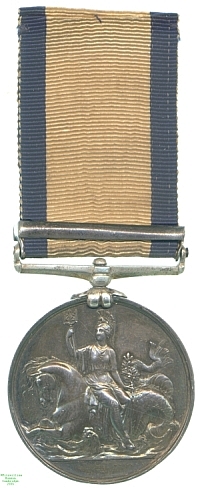
Obverse, a bust of Queen Victoria

Reverse, Britannia with a trident seated sideways on a seahorse

Obverse, a bust of Queen Victoria |

Reverse, Britannia with a trident seated sideways on a seahorse |
Just as in 1848 the extensive land campaigns of the Napoleonic Wars and the other conflicts of the pre-Victorian era were recognised by the issue of the Military General Service Medal, those serving in the Navy at the time were recognised with the Naval General Service Medal. As with the Army equivalent and the East India Company's related award, many of the battles for which the medal was awarded had been fought so long ago that few if any claimants survived.
In addition, bars were awarded for many actions whose significance and size were, despite the heroism displayed by those involved, relatively minor. The result was that many of the bars were issued in tiny numbers, with some combinations all but unique, and the medals command a very high price among collectors because of this rarity and individuality. This in turn, along with the manufacture in most cases of more bars than were eventually issued, has led to the `improvement' of many common awards where recipients' names are shared with those present at `rarer' battles. The medal also shares with the Military General Service and Army of India Medals the oddity that Queen Victoria, whose portrait they bear, was not the ruler under whom the battles for which it was awarded were fought.
Actions meriting the NGSM took place all over the globe, from the Caribbean to the Far East. Thus in September 1810 the British 5th-rate frigate HMS Ceylon, on troop-transport duty, was surprised off Madras by two French vessels and captured. Shortly afterwards however the two French vessels, a frigate Venus and a corvette Victor, were spotted towing the captured Ceylon by the British ships HMSS Boadicea, Staunch and Otter, at which point the Victor abandoned the Ceylon and left Venus to fight all three. She shortly surrendered, and was taken into British service as HMS Néréide. Bars were awarded to the NGSM for each vessel that took part in this battle, although by 1848 Staunch's and Otter's surviving claimants numbered only 2 and 8 respectively and Boadicea's men claimed only 14.
The rarity of this medal, which is inscribed to Boy John Wilson, a Marine aboard the Boadicea, raises questions. Wilson's presence on the ship at this time has been verified, but the Medals Roll lists the award of this medal only to a James Wilson, whereas several John Wilsons are listed for other clasps. Since this medal was at some point in the hands of a workshop--it has at some point in its history been mounted as a brooch--it is very possible that one of these John Wilson's medals has been retooled with the exceedingly rare Boadicea clasp to increase its value. Nonetheless, Lester Watson purchased this medal from the dealer Gifford at some point before 1928.